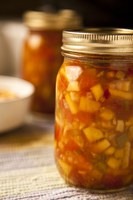Prairie Fare: Preserve the Fruits of the Season Safely
(Click an image below to view a high-resolution image that can be downloaded)
By Julie Garden-Robinson, Food and Nutrition Specialist
NDSU Extension Service
As I checked our family’s garden the other day, I noted the potential bumper crop of tomatoes coming our way. I recalled a scene from the season we built a raised garden bed. That year, I noticed a few partially eaten tomatoes on the grass outside the raised bed.
Eating tomatoes right out of the garden would not be something my kids would do, so my first suspects were the scampering red squirrels. They regularly store apples in the crooks of our trees. Maybe they were expanding their menu, I thought to myself.
However, the teeth marks were too large to be squirrel teeth. I certainly hoped we did not have giant mutant squirrels waiting to pounce on me as I picked tomatoes.
One night, one of our three dogs did not hop into the house on his last trip outside for the evening. I slipped on my shoes and headed outside. I found our dachshund Jake lying on his back near our garden by our abundant tomato plants. Jake always flips onto his back when he has been naughty.
I picked him up and carried him inside our house. He was panting. I could smell tomatoes on his breath and he had some tomato seeds on his fur. He was the tomato-eating culprit, so I was safe from giant mutant squirrels.
I really did not want our dog selecting his own food from our backyard because some plant foliage is toxic to dogs, cats and even people. The green stems and leaves of a tomato plant contain toxic components such as “solanine” that can cause gastrointestinal upset, diarrhea, weakness, loss of appetite and other symptoms. In the worst case, respiratory, cardiac arrhythmias or even death could result from eating large amounts of the leaves or stems.
Ripe tomatoes have only a tiny amount of the natural toxin, so the bites of tomato did not affect Jake. I think he felt guilty, though. We decided not to take a chance with our snacking pet. We put up a little fence around the garden, and I do not plant the tomato plants so close to the edge of the garden.
We will be canning tomatoes again this year, as will many people. The number of calls and emails from people around the state to our Extension county offices increases at this time of the year. Whether you are a seasoned canner or just getting started in home food preservation, be sure to follow current guidelines from the U.S. Department of Agriculture, National Center for Home Food Preservation and other reputable sources.
Sometimes I cringe when I read the guidance for home food preservation on random websites. Remember this: When you preserve food at home, especially by canning, you are a scientist. Food preservation isn’t the time to put on your “creative hat.” You need to put on your lab coat (or pretend that your apron is a lab coat).
Be sure to measure accurately and follow the directions closely. For example, if you plan to can tomatoes, be advised that tomatoes require adding an acid, such as bottled lemon juice or citric acid, as directed in our “Canning and Freezing Tomatoes and Making Salsa” guide (accessible at http://tinyurl.com/make-salsa-fn175). Tomatoes vary in the amount of acid they naturally contain. The pH, or acidity level of foods, determines the method you use to can foods.
Recently, I was asked whether oven canning is safe because some of the person’s friends were talking about it. The answer is “No, don’t do it.” One of our graduate students did an experiment with oven canning. She added bacteria to green beans, then processed the vegetables in jars in an oven. The bacteria survived. You might not.
An oven does not provide adequate heat transfer to kill potentially deadly bacteria and their spores (seedlike, heat-resistant forms of bacteria). Vegetables, meats and most mixtures of food require processing in a pressure canner. Fruits, jams and jellies, and research-tested salsa recipes can be canned safely in a boiling water-bath canner.
Another person asked me about using a dishwasher to seal jars. That is quite creative, but no, a dishwasher does not function as a boiling water-bath canner. You can wash your jars and keep them hot in a dishwasher, but use the appropriate equipment to preserve food.
If you are using paraffin wax to seal jellies, be aware that method was discarded as a safe way to seal food several years ago. Use standard two-piece lids, and avoid seal failures by following the manufacturers’ directions for preparing the lids.
Some lids no longer require heating prior to placement on the jars and heat-processing after they are placed on the jars. If the package does not recommend heating the lids, then just use them at room temperature as directed. Be sure not to overtighten the lids because they might buckle.
People also ask me if they could make up a salsa recipe and can it for all of their friends. If you happen to have an accurate pH meter to test the equilibrium pH and you are a food processing authority, then you probably are OK. Most people do not have lab equipment in their home, and food processing authorities are few and far between in the U.S. For safety, simply follow a tested recipe and you will be fine. You can freeze salsa recipes that you invent.
If you are using old family recipes, please be advised that recommendations have changed through time. Your great-grandma’s pickle recipe is not necessarily considered safe according to modern standards. Compare the recipe formulation to “modern” ones. If the yellowed recipe card has a relative’s handwriting, you might want to frame it as a keepsake if the recipe is not safe. She wouldn’t want you to become sick, either.
The NDSU Extension Service has a wide range of free, research-tested home food preservation resources on our website (https://www.ag.ndsu.edu/food), including canning fruits and vegetables, freezing, pickling, making jams, drying fruits and vegetables, and even making wine from locally grown fruits. Check it out by clicking on “Food Preservation” in the left-hand navigation.
Although we cannot grow mangos in our area, you might like to purchase some at a grocery store and try making this delicious salsa recipe developed by the National Center for Home Food Preservation.
Mango Salsa (for canning)
6 c. diced unripe mango (about 3 to 4 large, hard, green mangoes)
1 1/2 c. diced red bell pepper
1/2 c. finely chopped yellow onion
1/2 tsp. crushed red pepper flakes
2 tsp. finely chopped garlic
2 tsp. finely chopped ginger
1 c. light brown sugar
1 1/4 c. cider vinegar (5 percent acidity)
1/2 c. water
Wash and rinse half-pint canning jars; keep hot until ready to use. Prepare lids according to manufacturer’s directions. Wash all produce well. Peel and chop mango into 1/2-inch cubes. Caution: Wear plastic or rubber gloves while working with raw green mango. Do not touch your face, lips or eyes after touching or cutting raw green mangoes until all traces are washed away. Dice bell pepper into 1/2-inch pieces. Finely chop yellow onions. Combine all ingredients in an 8-quart Dutch oven or stockpot. Bring to a boil over high heat, stirring to dissolve sugar. Reduce to simmering and simmer five minutes. Fill hot solids into clean, hot half-pint jars, leaving 1/2-inch head space. Cover with hot liquid, leaving 1/2-inch headspace. Remove air bubbles and adjust head space if needed. Wipe rims of jars with a dampened, clean paper towel; apply two-piece metal canning lids. Process in a boiling water-bath canner for 10 minutes if your elevation is 0 to 1,000 feet, 15 minutes if your elevation is 1,001 to 6,000 feet or 20 minutes if your elevation is above 6,000 feet. Let cool, undisturbed, for 12 to 24 hours and check for seals.
Makes about six half-pint jars. One serving (about 2 tablespoons) of salsa has 29 calories, 0 grams (g) fat, 7 g carbohydrate, 0 g protein and 2 milligrams sodium.
(Julie Garden-Robinson, Ph.D., R.D., L.R.D., is a North Dakota State University Extension Service food and nutrition specialist and professor in the Department of Health, Nutrition and Exercise Sciences.)
NDSU Agriculture Communication - Aug. 6, 2015
| Source: | Julie Garden-Robinson, (701) 231-7187, julie.garden-robinson@ndsu.edu |
|---|---|
| Editor: | Ellen Crawford, (701) 231-5391, ellen.crawford@ndsu.edu |



